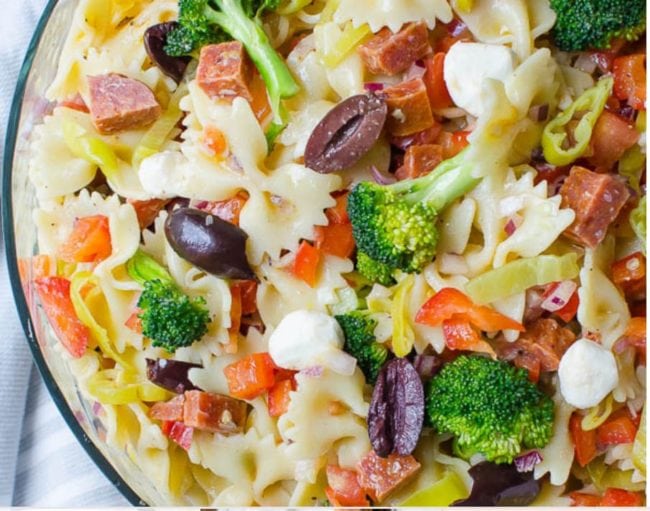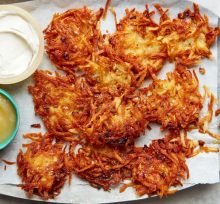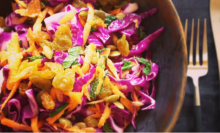
A great way to bring the health benefits of olive oil in this Mediterranean Diet recipe classic.
Updated September 5th 2022
Like many world-renowned chefs, we at Morocco Gold have been inspired by the tastes of The Mediterranean diet – with its polyphenol rich health benefits and emphasis on vegetables, whole grains, olive oil and seafood. This tasty tuna pasta salad recipe is brought to life with our extra virgin olive oil and can be made very quickly.
Olive Oil – and in particular the best extra virgin olive oil you can find – is one of the best sources of antioxidant polyphenol compounds you can include in your diet. The oil from our latest harvest has a whopping 644mg/kg polyphenol content – our highest ever – meaning that you can be assured every last drop will bring all kinds of benefits to your health.
One of the most family-friendly, quick and simple ways to include a quality extra virgin olive oil in your diet is to knock up a fresh pasta salad combining your favourite Mediterranean foods for an instant health hit.
Here is one of our favourites – which can be altered by swapping pepperoni with a oily fish of your choice such as yellowfin tuna.
Tuna Pasta Salad : A Great Mediterranean Diet Recipe
Ingredients
- 16 ounces spiral pasta
- 1 head fresh broccoli, cut into bite size pieces
- 1 head fresh cauliflower, chopped in to bite size pieces
- 1 red onion, chopped
- 2 teaspoons minced garlic
- 8 ounces pepperoni slices, cut in to quarters
- 8 ounces mozzarella cheese, cut in to cubes
- 6 ounces large pitted black olives, drained and sliced½ cup Morocco Gold Extra Virgin Olive Oil
- ½ cup red wine vinegar
- Salt and pepper to taste
- Italian seasoning to taste
Instructions
- To start making your tuna pasta salad start by bringing a large pot of lightly salted water to a boil. Place pasta in the pot, cook for 8 to 10 minutes, until al dente, and drain. Transfer to a bowl, cover, and chill 1 hour in the refrigerator.
- Toss chilled pasta with the broccoli, cauliflower, red onion, garlic, pepperoni, mozzarella cheese, olives, olive oil, and red wine vinegar. Season with salt, pepper, and Italian seasoning. Chill in the refrigerator until serving.
- Couldn’t be easier, right? Appreciate the healthy tuna pasta salad.
What Is Yellowfin Tuna?
Yellowfin is a species of tuna that is found in the Gulf of Mexico and the Atlantic and Pacific Oceans. The scientific name for the yellowfin tuna is Thunnus albacores. Other names for yellowfin tuna include ahi and Allison tuna. Although the average yellowfin tuna weighs 80 pounds, they can weigh up to 400 pounds. Yellowfin tuna is a low-calorie and low-cholesterol protein source.
Main Nutrients
A 3-oz. serving of yellowfin tuna has 93 calories. This portion provides 21 grams of protein and has 0.42 grams of fat. It has 0.15 grams of saturated fat, which is less than 1 percent of the daily value (DV) for a 2,000-calorie diet. This serving has 0.10 grams of monounsaturated fat and 0.13 grams of polyunsaturated fat. The cholesterol content is 33 mg, or 11 percent of the DV. Tuna contains no carbohydrates, fibre or sugar.
Minerals
Yellowfin tuna’s selenium content (77 mcg) is 110 percent of the daily value for a 2,000-calorie diet. It has 24 percent of the DV for phosphorus — 236 mg. The 375 mg of potassium contributes 11 percent to the recommended daily intake. This serving has trace amounts of calcium, copper, iron, manganese, magnesium and zinc. Yellowfin tuna provides less than 1 percent of the daily value for these minerals.
Vitamins
The main vitamin that yellowfin tuna provides is niacin. This B-vitamin helps your body create energy from the fat, carbohydrates and proteins in the foods that you eat. It also plays a role in proper nerve functioning and blood circulation. A 3-oz. serving has 16 mg of niacin, or 79 percent of the DV. It also provides 40 percent of the DV for vitamin B-6, 30 percent of the DV for vitamin B-12 and 15 percent of the DV for vitamin D. The trace amounts of vitamins A, C and E in this serving do not contribute significantly to your nutrient intake.
Considerations
The nutrient profile for tuna makes it a healthy addition to your diet, with some restraints. The methylmercury contamination levels for tuna are higher than levels for smaller fish that do not live as long as tuna do. Instead of excluding tuna from your diet, enjoy this fish less often. The U.S. Food and Drug Administration recommends limiting your consumption of fish with higher amounts of mercury to 6 oz. or less per week. Growing children and pregnant women should avoid eating these fish species, including yellowfin tuna.
Important Disclaimer
The information provided on this website is for general informational purposes only. All content, including text, graphics, images, and information, is presented as an educational resource and is not intended as a substitute for professional medical advice, diagnosis, or treatment.
Please consult with a qualified healthcare provider before making any decisions or taking any action based on the information you find on this Website. Do not disregard, avoid, or delay obtaining medical or health-related advice from your healthcare provider because of something you have read on this Website.
If you think you may have a medical emergency, call your doctor, go to the nearest emergency department, or call emergency services immediately. We are not responsible for any adverse effects resulting from your use of or reliance on any information or content on this Website.
By using this Website, you acknowledge and agree to this disclaimer in full.



